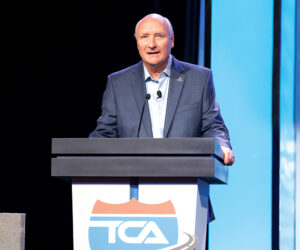For this article, three industry stakeholders shared their thoughts about the top concerns report, including Andrew Boyle, co-president of Boyle Transportation; Brenda Neville, president and CEO of the Iowa Motor Truck Association; and David Heller, vice president of government affairs at the Truckload Carriers Association.
For the past five years, the driver shortage has headed up the list of critical issues in the trucking industry report published by the American Transportation Research Institute (ATRI) based on a survey of motor carrier executive and professional truck drivers.
So concerned were survey participants about the issue that the driver shortage garnered more than four times as many first-place votes as the next-closest issue in the 2021 survey. In fact, no other issue generated as many overall votes in the survey.
The current shortage, set at 60,000 drivers by industry stakeholders, could easily reach 160,000 by 2028.
In addition to ranking the concerns, survey participants were asked to rate three strategies for remedying each concern.
For the past four years, the No. 1 strategy to alleviate the driver shortage has centered around advocating a pilot program to expand the commercial vehicle license (CDL) interstate eligibility for 18- to 20-year-old drivers.
Heretofore, the industry has been unsuccessful with the strategy.
The Federal Motor Carrier Safety Administration (FMCSA) did propose such a pilot program during the Trump administration, but the proposal was dropped by the Biden administration.
Fortunately, the DRIVE Safe Act now before Congress provides an apprenticeship program for 18- to 20-year-old drivers that could accomplish what the trucking industry desires.
Most congressional watchers believe the DRIVE Safe Act will become law in the not-too-distant future.
Not only was the driver shortage the No. 1 issue in the survey; it was also part of a trifecta that showed key driver issues were indeed on the minds of industry stakeholders. No. 2 in the survey was driver retention, and No. 3 was driver compensation.
The driver shortage is a long-time issue, according to David Heller of the Truckload Carriers Association (TCA).
“The driver shortage has existed for as long as the industry has been around, dating back to the very first “Drivers Wanted” signs that were posted in store front windows,” said Heller. “That being said, the most glaring example of how much the driver shortage relates to the real world is by using the barometer of what store shelves look like.”
Andrew Boyle concurred, and noted other shortages.
“The labor shortage is not unique to trucking,” he said. “There are macro factors at work — the percentage of adults working is still only 61.6% as of October 2021, versus 63.4% in early 2020. The causes of that decline can be debated, but the fact is that millions fewer Americans are working. At the same time, an increase in
demand and low inventories mean that more emphasis is placed on just-in-time transportation.”
As for the DRIVE Safe Act, Brenda Neville is optimistic.
“Based on the conversations I have had with our elected officials in D.C., there is a lot of support and interest in the DRIVE Safe Act/apprenticeship program,” she said. “This is also something that both Republicans and Democrats can get behind, so I remain hopeful that we will continue to make positive gains in this direction.”
Beyond the Top 3 concerns for 2021, as usual, the survey revealed a smorgasbord of issues; all but one repeats from at least one year dating back to 2012.
The first-timer on the list is a concern about the growing shortage of diesel technicians.
The U.S. Bureau of Labor Statistics estimates there will be over 28,000 openings for diesel service technicians and mechanics for each of the next 10 years; median pay in 2020 was just over $50,000.
Depending on whose data you use, the immediate need is critical.
According to projections from TechForce Foundation, demand for new diesel technicians will top 35,000 by 2024.
According to the survey respondents, the best strategy to alleviate the shortage is to encourage collaboration between motor carriers and technician training schools to promote technician training and placement.
Neville said that for far too long, young adults have been encouraged to pursue a four-year college degree, and that has created shortages across the board in the trucking industry as well as a number of trade segments.
“There is now a shift, and we are finally seeing a concerted effort to highlight the value of pursuing programs that require a minimal amount of training and offer significant benefits especially when it comes to income potential,” she stated. “But we have a lot of ground to make up before we are going to see the ROI on this new perspective. In the meantime, I believe we will continue to see companies offering very attractive packages beyond just pay to get these young kids into these important jobs.”
Heller said he believes the shortage can be attributed to the current environment the nation is facing, rather than an industry-specific issue.
“Retirement, natural attrition because of COVID, and even job hopping has affected the industry in a manner that quality technicians are becoming harder and harder to recruit,” he said. “Much like a professional truck driver, this profession is one that has shown itself to be highly skilled and in demand.
“As an industry, identifying and training more people must be done so that our nation’s fleets can continue to be well maintained in the safest and most effective way possible,” Heller continued. “I know we are dedicated to changing the way people think about this kind of job. In the long run, people will recognize this profession as an opportunity for advancement for those who choose to make this a career.”
Conspicuously absent from the 2020 list of Top 10 concerns was hours of service (HOS), which had been listed as a concern since 2012. In 2013, 2014 and 2015, HOS was noted as the No. 1 concern. HOS has been a hotbed of debate since 2003, when the FMCSA increased the number of hours that could be driven in a 24-hour period from 10 hours to 11 hours. It was the first major overhaul of HOS since 1962.
In all, seven of the Top 10 concerns relate to drivers is some form. Besides the top three, Truck Parking was No. 5, CSA was No. 6, Detention Delay was No. 7, Infrastructure/Congestion/Funding and the aforementioned Diesel Technician Shortage was No. 10.
Over 2,500 industry stakeholders across North America weighed in with their opinions. The respondents represented motor carrier personnel (52.4%), commercial truck drivers (24.1%), and other industry stakeholders (23.5%), including industry suppliers, driver trainers, and law enforcement.
ATRI noted that the 2021 survey was taken with a new Democratic administration and Congress in place — and with those changes came a new focus on social programs, climate change, and workforce issues. The post-pandemic economy has included a record infusion of stimulus, a push for zero-emission vehicles, labor shortages, and vaccine mandates for employers with over 100 employees.
Lyndon Finney’s publishing career spans over 55 years beginning with a reporter position with the Southwest Times Record in Fort Smith, Arkansas, in 1965. Since then he’s been a newspaper editor at the Southwest Times Record, served five years as assistant managing editor of the Arkansas Democrat-Gazette in Little Rock and from November 2004 through December 2019 served as editor of The Trucker. Between newspaper jobs he spent 14 years as director of communications at Baptist Health, Arkansas’ largest healthcare system. In addition to his publishing career he served for 46 years as organist at Little Rock’s largest Baptist church.








